#placoid
Explore tagged Tumblr posts
Text

There are four types of fish scales!
Cycloid scales are thin, overlap, and flexible. They're found on primitive teleosts (like minnows and carp).
Ctenoid scales have small, backwards pointed scales (known as cterns) make the fish more hydrodynamic and faster. They're found on Advanced Ctenoids (like perch and sunfish).
Ganoid scales are thick, diamond-shaped, and mostly non-overlapping. They're found on Chondrostei (like sturgeons and paddlefish).
Placoid scales are spikey and tooth-like with nerves. These are found on Chondrichthyes (like sharks and rays).
Ichthyology Notes 3/?
#science#biology#animals#ocean#wildlife#marine ecology#animal facts#marine life#fun facts#marine biology#fish#fish facts#fins#fish fins#scales#fish scales#ichthyology#fish anatomy#anatomy#minnows#carp#perch#sunfish#sturgeons#paddle fish#sturgeon#paddlefish#shark#sharks#rays
20K notes
·
View notes
Text
Round 2 - Chordata - Chondrichthyes
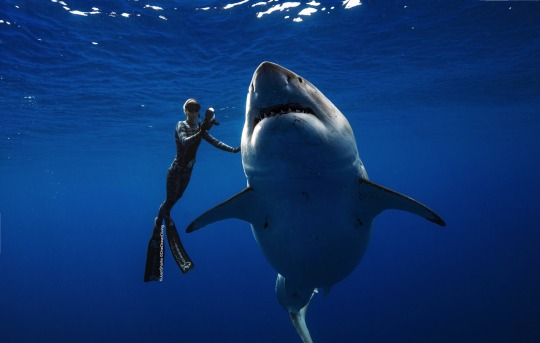
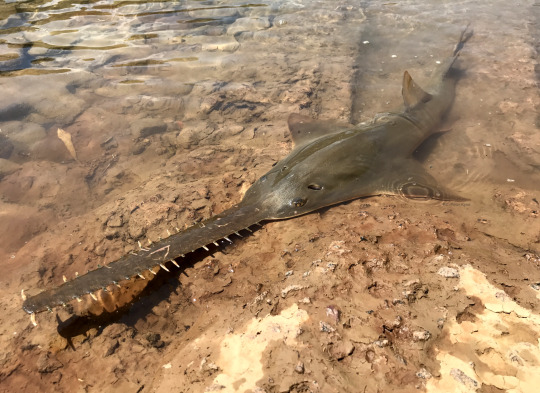
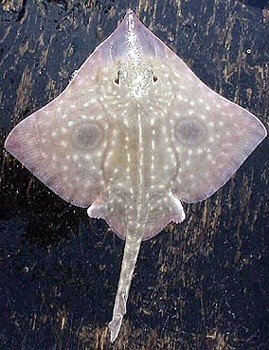
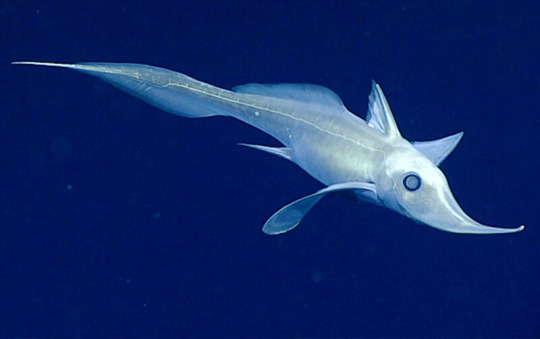
(Sources - 1, 2, 3, 4)
Chondrichthyes is a class of jawed fish, commonly called “cartilaginous fish” due to their skeletons composed mainly of cartilage, making them distinct from all other vertebrates. They are comprised of the superorders Selachimorpha (“Sharks”), Batoidea (“Rays”), and Holocephalimorpha (“Chimaeras”).
Chondrichthyans breath through gills but lack opercula (gill coverings) and swim bladders. They have paired fins, paired nares (nostrils), and placoid (tooth-shaped) scales (except for electric rays, which have loose, soft skin). These placoid scales, also called dermal denticles, provide protection and streamlining, giving the animal’s skin a sandpaper-y feel. All chondrichthyans breathe through five to seven pairs of gills, depending on the species. As a general rule, pelagic species usually must keep swimming to keep oxygenated water moving through their gills, while demersal species can actively pump water in through their spiracles (a small hole or slit behind each eye) and out through their gills. Most larger, pelagic species no longer have spiracles. Chondrichthyans have many sensory organs to perceive the world around them. Their nostrils are attached to powerful olfactory organs. Around their face are a network of electroreceptors called Ampullae of Lorenzini, which allow them to sense electrical fields. Their lateral line has modified epithelial cells which sense motion, vibration, and pressure in the water around them. However, their sound-detecting apparatus has limited range and is typically more powerful at lower frequencies. Some species have electricity-producing organs which can be used for defense and predation. Chondrichthyans have a diverse array of shapes and sizes, ranging from the 10 cm (3.9 in) long, electric Finless Sleeper Ray (Temera hardwickii) to the over 10 m (33 ft) long Whale Shark (Rhincodon typus). All species are carnivores: some predatory, some ambush-hunters, and some filter-feeders. At least one species is omnivorous. Chondrichthyans have internal fertilization and most species give live birth, while some lay eggs. There is no parental care after birth, though some chondrichthyans do guard their eggs.
Chondrichthyans are considered to have evolved from Acanthodians, which appear from the Early Silurian. The first sharks began to evolve in the Devonian Period, though, while often claimed to be relatively unchanged, modern forms did not start appearing until the Early Jurassic.
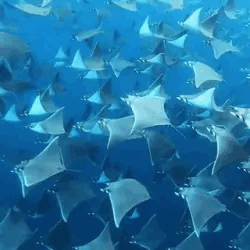
Propaganda under the cut:
Mentioned briefly above, the Bonnethead Shark (Sphyrna tiburo), a small species of hammerhead, is the only shark known to be omnivorous. While it feeds on crustaceans, molluscs, and small fish, it also ingests large amounts of seagrass, which has been found to make up around 62% of gut content mass.
Also mentioned briefly above, Electric Rays (order Torpediniformes) are known for being capable of producing an electric discharge, ranging from 8 to 220 volts, depending on species, used to stun prey and for defense.
There are over 500 different species of sharks, and only a dozen could be considered dangerous to humans. That being said, of those 12, most do not seem to like the taste of human flesh, and bites are usually accidental or exploratory.
Many pelagic chondrichthyans occasionally breach, leaping out of the water. This can be done for hunting purposes, as a mating ritual, to shake off parasites, or even just for fun!
Today, all species of Sawfish (family Pristidae) are critically endangered. However, they were relatively common in the Cretaceous, where they were likely a common food source for Spinosaurus.
(Confusingly, Sawfish are a type of ray while Sawsharks (order Pristiophoriformes) are a type of shark. Sawsharks live in the deep sea and are rarely seen, while sawfish live in coastal and brackish waters.)
Kitefin Sharks (family Dalatiidae) have bioluminescent organs which glow blue in the dark
Chimaeras have a strange pair of teeth in their lower jaw which look like rodent incisors, giving them the common names “ratfish” or “rabbitfish.”
Great White Sharks (Carcharodon carcharias) are regularly hunted by orcas, and when one is confronted by an orca it will generally flee and not return to that area for up to a year.
Manta Rays (genus Mobula) are incredibly smart. They were the first “fish” in the world to pass the “mirror test” (ie show self-awareness by recognizing themselves in a mirror rather than seeing the reflected image as another manta ray). They also have highly-developed long-term memory, form friendships, and play with each other by blowing bubbles and breaching out of the water.
243 notes
·
View notes
Text
I Have Seen Your Tags on the supershark/"shark kent" post and i agree (1) "smooth sharking" is absolutely a thing people do about superman once word gets out about his (too-fine-to-be-immediately-visible) placoid scale situation, and (2) other people in bruce wayne's life absolutely troll him with it and he takes the bait every time because he HAS to correct people. he refuses to just roll over and say Yeah He's Smooth Actually. he'll just grapple-gun out of the room if you try to bring it up after a certain point
244 notes
·
View notes
Text
one thing i do like about TOTK is that it confirms that zora have placoid scales (at least the pigmented ones)
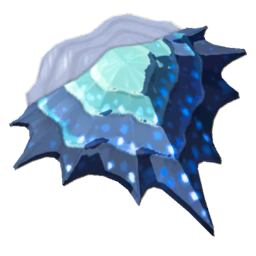
47 notes
·
View notes
Note
Siren world building!!!! Whatcha got so far?
Ok so....my notes are all in one place so I'll do this off the tops of my head. Buckle up tho cause this'll be long. Edit: I lost a lot of the lore as I was compiling it so this might be shorter than I intended it because I cant remember everything I put down. Fml.
SIREN PHYSIOLOGY:
1. Types? Scales?
Sirens come in three types, Tropical/Coral Reef, Open sea, and deep sea.
Tropical sirens have cylcoid and ctenoid scales, as they typically aren't migratory at all. Depending on the type of tail they could have both ctenoid and cylcoid (ctenoid on the back facing parts and cycloid on their bellies/undersides) but most only have very colorful and patterned cylcoid scales. They also have very flowy and frilly fins like betta fish and angel fish. They also appear the closest to how the myths are about beautiful half human half fish people but the difference is that all sirens are covered in scales. Majority of the sirens bodies are covered in scales besides some of the chest area, head, and scalp, especially in the case of tropical sirens.
- side note, the different types of sirens aren't different species of sirens. Its more like morphological and cultural differences like Darwin's finches or the races we humans have made up for ourselves. If anyone sees this and doesnt know, race is NOT biological. If it was then we wouldn't be considered the same species.
Open sea sirens have shark-like placoid scales, which help them move easily and silently in the water to be speed-ambush predators. These types of sirens are also migratory and travel in pods of close family members. They have a tendency to have dull patterns or no patterns at all and have sharklike fins. Since they are migratory they mingle a lot with other open sea pods and have strong family bonds. They have scales all over their bodies and have little hair because it interferes with their swimming.
Deep sea sirens, on the other hand, are scale-less and tend to resemble deep ocean fish, particularly anglers and eelpouts. These tend not to have extensive patterns and are all solid colors. Their fins also tend to be reminiscent of eel skin. These sirens typically also never venture to the surface and it is very rare for any other sirens to meet one as deep sea sirens tend to live alone.
2. Genitalia? If they're mammals, how do they produce milk.
Sirens, no matter the form, have internal genitalia. This leads to male sirens in their human form often being mistaken for human females.
As for the production of milk, they do the same thing that whales do. They also give live births instead of laying eggs.
3. Size and biological sex?
Female sirens are much bigger, stronger, and tend to be bulkier than male sirens. As such females typically cap out at 12-13 feet long in siren form and males tend to cap out at 10-12 feet in siren form.
The biological sex of sirens can only be visually determined by the size of the siren. Otherwise there is no physical distinction between the two. They all tend to have the same or consistent patterns between them, they have the same body builds, etc. Its just that females are bigger and typically stronger than the males. However siren males tend to be faster than the born females.
4. Siren songs? Strength of their voice?
Siren songs have the ability to control human minds and make humans of any gender or sexuality jump off their boats, thus making their ships or vessels ghost ships.
The strength of a sirens voice is determined by their confidence. Older sirens tend to have stronger voices because they are more confident in their uses.
The volume of the songs though is around the volume of a whale call, which is LOUD. Out of the water if a siren uses its call it would be louder than a jet engine.
5. Siren eyes
Siren eyes are unusual because the irises are pearlescent and come in any color that pearls do. They also have fisheye lenses. The shinier the eyes the better. Why did I make them this way? Because its cool thats why.
Also, most deep sea sirens are blind since its dark where they live. They usually use their vestibular senses, smell, and touch in order to tell where they are and where their prey is.
6. What foods can they eat?
Sirens eat mostly fish, shellfish, kelp, seaweed, sea urchins, whale falls, scavenged meals, etc. They can also eat most human foods, but they have an intolerance to fruits and nuts. They can eat them, but its similar to a human thats lactose intolerant. Not that thats ever stopped my OC and his kids from fucking up a couple of mangoes.
7. Human forms, gills, and breathing
All sirens can disguise themselves as human and thus have human forms. Since the sirens size is impacted by their biological sex, female sirens disguised as humans are typically 6-7, sometimes 8, feet tall while male sirens typically come around 4'5-6' even in human form. It is typically only slightly painful to shift forms, but becomes extremely painful if the siren is already ill or exhausted. Most sirens, even if they shift forms often, find it slightly annoying but not much else.
Sirens have two modes of breathing that allows for this to happen. They have a set of human lungs, nostrils, and two sets of gills. Their sets of gills are located on the neck and just below the ribs so that even if one set is above water theres another as a backup. Their gills can also close up the entire way, which to the untrained eye makes them look like scars when in human form or not in use. Their nostrils, when in the water, also automatically close and their gills automatically open.
Switching from nostril breathing to gill breathing and vice versa is typically painful for the first few breathes. As such, young sirens prefer to stay in one form over the other until their teenage years.
Most young sirens after birth will stay only in their siren forms until they are around 5 years old, and then they will begin shifting forms (if applicable to the type) and learning how to walk on two legs guided by a parent siren. Most deep sea sirens never do this, as they tend to stay in the deep ocean. Some open sea sirens do it and the majority of tropical/Coral Reef sirens do this.
8. What do land sirens need to do to stay healthy?
A siren can stay fully out of the sea for up to 3 months without physically damaging themselves past the dulling of skin, hair, and scales. But most sirens will go back to the sea every month during the full moon (because that is when the tides are the strongest) to revitalize themselves. This is what my OC and his children do to stay healthy.
Otherwise, they have boosted immune systems and rapid healing and do not need to do much to stay healthy.
CULTURE OF SIRENS:
1. Money? Economy?
Most of the economy is based on a trade and barter system. An ill do this for you if you give me this or something like that. "I'll give you these fish i caught if you make me a basket" or "I'll make you a fishing net in exchange for this ring" that sort of thing.
Though there is currency for when trade is unavailable, whether it be because the item or service you want is too expensive to trade or because theres no trade etiquette for it. These consist of pretty shells (the more symmetrical, uniform patterns, and unbroken the better) or perfectly shaped and colored pearls.
2. Matriarchal or Patriarchal?
This society is majorly matriarchal with a focus on protecting and raising children. The emphasis on raising children isnt based on social pressure, but more so of the expansion of the pods because giving birth is a rare occurrence. Most sirens only have one to three children in their lifetimes, of which consist of around 100 to 150 years.
The reason that sirens are matriarchal is based on the fact that they are the ones that bear the children. The sirens see this as a divine feat worthy of worship, and also because matrilinial lines are easy to keep track of.
3. Jewelry and tattoos
Most deep sea sirens do not have any jewelry or tattoos because they are mostly solitary and unsociable. However tropical and open sea sirens have lots of tattoos and jewelry to explain.
Jewelry is usually made of braided seaweed, kelp, shells, metals, sea glass, and pearls.
The more expensive materials like metal, pearls, and sea glass are usually reserved as gifts for loved ones or to show family status. Matriarchs and patriarchs (the head matriarch and her first husband) tend to be the receptical of the more elaborate pieces of jewelry. The matriarch of course, receives the *most* elaborate pieces as is pod tradition.
Tattoos on the other hand have meanings. Different tattoos (that i still need to design) have different meanings in the pods. A lot of the tattoos signal different pod families and branches of those family. For example, my OC comes from the key pod even if he branches off and starts his own, so his tattoos contain base elements of the key pods designs. The tattoos must contain the latest pod you belong to. Meaning his children would have the elements of his current pod, and not from the key pod. Does that make sense? This is done so that when children break away from their parents they can start their own distinct family structures while still keeping their roots and easily tracing family trees.
These family tattoos are usually tattooed onto the backs of the sirens, as they cannot be easily hidden or taken away. The other tattoos like warrior tattoos and honor tattoos are placed on the arms.
The most important tattoo anyone could ever get in this society, though, is the tattoo of the child bearer and the child rearer. These tattoos are placed on the stomach around the area of the womb on a female and below the naval on a male and they signify that these two have produced and raised children. Different lines signify how many children you've given birth to or raised.
For example, my OC is a Trans man siren who has given birth to three siren babies but has adopted more children, making his grand total of lines to be 10 because he has raised 10 children.
4. What do they use pearls for? What do they use siren scales for?
They use pearls for many different things. They use it for jewelry, ceremonies, and money. The most common use for pearls is for jewelry that shows status among pods and marital status.
For most jewelry, imperfect pearls are used. That is pearls with unusual shapes, sizes, and colors. Since sirens are matriarchal, the head matriarch of the family will have the more perfect pearls while the rest of the family pod will get the more imperfect ones. The higher in pod status you are the more perfect the pearls.
To propose many sirens will give the sirens of their affection their shiniest scale. If the other siren accepts the proposal, they will wear the scale on a belt. The number of partners a siren has will be shown on the belt (with the different scales) and will be accompanied by a braided seaweed and shell bracelet. The amount of shells on the bracelet, accompanied by a small scale to show who the partner in question is, will show how many years the siren has been married to the other. It is often a big deal when the amount of years on a siren pairs bracelets can't fit on a bracelet and has to be made into a necklace instead.
Perfect pearls are often used as currency or offerings to the divine feminine sea on shrines. More on that in a later post if y'all want.
5. Clothing
It is dangerous for sirens to wear traditional human forms of pants or forms of underwear as theres a risk of their tails being tangled/hurt while ripping the fabric in need of an urgent transformation (because clothes dont change with them) so they usually wear flowy and light things that can be easily untied or tied.
Also, because of the fact that sirens have internal genitalia, sirens are not particularly prudish or ashamed of their genitalia. They often get in trouble with humans for being too exposed because sirens don't have the same version of modesty that humans do.
Most outfits that sirens wear when in human form is similar to these pictures here:

6. Different romantic relationships taboos.
Deep sea sirens do not have much in the way of social lives, so they rarely form romantic attachments to any other sirens, much less aby sirens outside of their own type. It is exceedingly rare to see a deep sea outside of their natural hunting grounds.
Intermixing between siren types isn't taboo. it's just uncommon because of all the different behavior types. Two types of sirens are usually stationary while one type is migratory. The most likely to encounter each other are tropical and open sea sirens.
What *is* taboo however is siren and human romances. Mainly because historically humans have, and in this world still do, hunt sirens and make trophies out of them. There are safe villages that I can elaborate on later in another post if anyone is interested, but they are not the norm. Very rarely do sirens and humans form romantic relationships unless the siren is mostly on land, and when they do form those relationships the older generations of sirens are typically opposed while the newer generations are typically more accepting.
#worldbuilding#sirens#mythology and folklore#my own world#my writing#writing#stories#writers on tumblr#writerscommunity#im also happy to bounce ideas off of one another if anyone is interested#mermaids
13 notes
·
View notes
Text
Meet the Rivulet! (Splitmind AU)
Reblogs > Likes (Reblogging helps out a lot, even if it doesn't seem like much!)
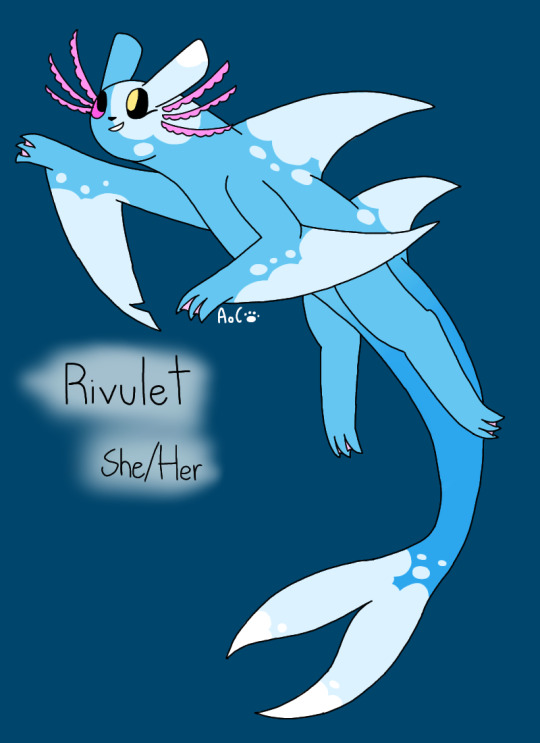
It's Ruffles time!
Lore under cut, includes pre and post Scugerator
Quick tidbit about her design, is that as I draw more designs, I slowly make these slugcats less cat-like and just go more and more nuts, with the Splitmind AU being very different. Rivulet isn't even furred, but instead has placoid scales and has a more sharkskin feel to her.
Also, something you'll see with more of the AU is that scugerators will have their left eye black with a pupil colored like the iterator inside the scug. The only time this changes is when the iterator takes temporary control (whether willingly or through force), where both eyes become reflective of the iterator.
Moots, Interested, or Ones who I think will be interested
@doodlebug091
@keeper-of-magic
@angeliteonfridgeduty
@stupidscav
@batnip
@riverripplespeaks
@cherry-b0mber
@luxdraconia
@voldkat
@lunas-sketchbook
Pre - Moon
Before Moon placed her consciousness in the paws of a slugcat, Rivulet was just an aquatic beast that lived in Shoreline, mostly near the seafloor of the ocean and only coming up every so often to sunbathe or hunt if her normal prey was scarce. (Splitmind Rivulet has true gills, so she can live underwater. She also still has lungs, don't worry, evolution didn't screw her over too bad)
Rivulet lived a solitary lifestyle, only coming into contact with one other slugcat in their life, who simply came and went. At some point, she did visit the local iterator before their collapse, and was given the Mark of Communication before going back to the life she usually lived.
After the iterator collapsed, Rivulet started collecting some of the scraps that washed into the sea, such as pearls, bits of metal and wiring, and even a rarefaction cell (and a lot more damaged cells too). Eventually, she saw another slugcat traveling to the iterator, and out of curiosity, she followed them to watch as they brought the lifeless puppet back to life. After the other slugcat left, Rivulet dropped down to listen to Moon's stories, and would even stay in the chamber when the rains came since she could still breathe.
Post - Moon
After several cycles of living with the iterator, Rivulet saw another slugcat enter the chamber. After initially being hostile towards them, Moon wanted to investigate after the slugcat drew a pearl from a pouch and handed it to her before speaking to both of them, despite marks not being two-way communication. The creature explained that it was an iterator inside of the slugcat's mind, and it hoped this could be a convoluted way to ascend themselves by binding their own minds to another, more feral creature. The pearl contained the instructions on how to do such.
Without lingering for much longer to answer any questions, the creature then gave a suggestion that, normally, it would prefer to genetically engineer the perfect host for such a task, but in Moon's condition, it could be less stressful on her fragile systems to use what was on-hand.
After reading the pearl, Moon asked Rivulet if this was something she was okay with: An iterator in her mind. Rivulet agreed, having grown fond of Moon's presence, and wanted the best for her. Moon went ahead with the process, transferring her mind to Rivulet's.
With a newfound consciousness alongside her own, Rivulet originally wanted to try ascending straight away, but Moon encouraged her to spend some time exploring and showing her things she'd never seen before. Rivulet began doing just that, and Moon offered insight into things that Rivulet didn't understand. The two meshed perfectly, and in the end, the choice Rivulet made was one she never regretted.
Rivulet also met some of the other scugerators on her travels, namely, a feisty and explosive slugcat that had the same telltale eye, but refused to open up on who or why. The slugcat, Artificer, had two missions: Kill the scavenger cheiftain, and then ascend. Rivulet wanted to help, at least with the ascension, and accompanied Artificer on parts of her journey until finally taking her to the new place the scavengers had set up, Bitter Aerie in the remnants of Moon's structure.
After Artificer had done what she wanted, Rivulet took her to meet echo after echo, though both the echoes and Moon told Rivulet that something was wrong with Artificer, as a carnal desire bound her to this world. Despite this, Rivulet still guided Artificer through the world until they'd reached Subterranean, where the guardians (obviously) attempted to attack Artificer. With Rivulet's speed and a bit of trickery, she was able to sneak Artificer past them and eventually, to the void sea.
Riv watched Artificer go, but shortly after could see the golden shimmers in the water and almost saw the red slugcat being fragmented. Confused and worried, especially after seeing what looked like the slugcat trying to claw her way back to the surface, Rivulet dove in to save her. Despite the pain of the void fluid starting to dissolve her body, Rivulet managed to grab Artificer and pull them both out before either could echo/ascend.
After this, Artificer said she was going to 'make things right', and after the two sheltered together, disappeared into the world. In attempts to find her lost friend, Rivulet found a trio of slugcats that didn't have the telltale eye and instead, seemed like just that: Slugcats. As she talked to them and got to know the three, a pair of siblings and the third being like an adoptive one, she became friends with them as well and tries to visit them as often as she can, since she still roams the world looking for Artificer.
36 notes
·
View notes
Text
Mod 2 General Topics
Types of Fins
Fins are thin, broad folds of integument internally supported by fin rays, they aid in locomotion in various ways depending on the type of fins.
There are 2 kinds of adult fish fins: unpaired median and paired lateral.
Unpaired median fins include 1-2 dorsal fins along the mid-dorsal line, a ventral anal fin behind the anus/cloaca and a caudal fin around the tip of the tail.
Paired lateral fins include pectoral fins anteriorly and pelvic fins posteriorly. Pelvic fins are called thoracic when located below the pectoral fins and abdominal when located just above the anus. Absent in some.
Under unpaired fins there are many types of caudal fins. Caudal fins are well developed in most fish because of its important contribution to forward propulsion during swimming. The 3 main types are: diphycercal, heterocercal, and homocercal.
Diphycercal Fins:
The most primitive, not exhibited by many living fish.
Vertebral column extends straight back to the tip of the tail, dividing the fin symmetrically and equally into the dorsal and ventral lobes.
Occurs in cyclostomes, primitive sharks, and lungfish.
Presence of diphycercal tail in developed fish is due to secondary modifications.
Heterocercal Fins:
Intermediate type.
The caudal fin is strongly asymmetrical.
Vertebral column bends upwards and reaches up to the tip of the more prominent dorsal lobe.
Characteristic in bottom feeders with a ventral mouth, the stroked of the large dorsal lobe directs the fish downwards.
Occurs in modern sharks.
The opposite, a large ventral lobe, is found in flying fish to propel them upwards. This type of fin is called hypocercal.
Homocercal Fins:
The most advanced type and the most common.
Characteristic of most higher bony fishes.
Externally symmetrical but internally asymmetrical.
The original dorsal lobe or epichordal is suppressed, the original ventral love is developed into a single or 2 symmetrical lobes.
Characteristic of fishes with a terminal mouth, its strokes force the fish straight forward.
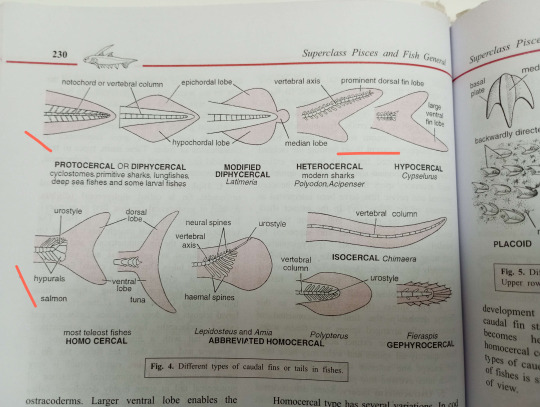
Types of Scales
There are 5 types of dermal scales: Cosmoid, Placoid, Ganoid, Cycloid, and Ctenoid.
1. Cosmoid Scales:
Does not occur in living fish, only fossilized fishes.
2. Placoid Scales:
Characteristic of sharks.
Each scale has a backwardly directed spine arising from a round or rhomboidal basal plate embedded in dermis.
Spine is enamel-like and basal plate is of dentine-like bony material.
A pulp cavity inside the spine opens through basal plate.
Placoid scales are closely set together in skin; giving a sandpaper like texture.
3. Ganoid Scales:
Thick, rhomboidal, or diamond shaped plates closely fitted side by side. Tile like, provide a bony armor to the fish, might overlap in some.
Characteristic of holosteans.
4. Cycloid Scales:
Thin, flexible. translucent plates. Circular in outline and thicker in the center.
Marked with several concentric lines of growth which can be used to determine age.
They overlap each other, each scale is embedded in a small pocket of dermis.
Found in lung fishes, carp, cod, etc.
5. Ctenoid Scales:
Similar to cycloid scales in form, structure, and arrangement.
But is more firmly attached, their free hind parts with are not overlapped, bear numerous small comb-like teeth or spines.
Characteristic of modern higher teleosteans like perch and sunfish.
There are some intermediate types of scales found in between cycloid and ctenoid, and some fish like flounder have both.
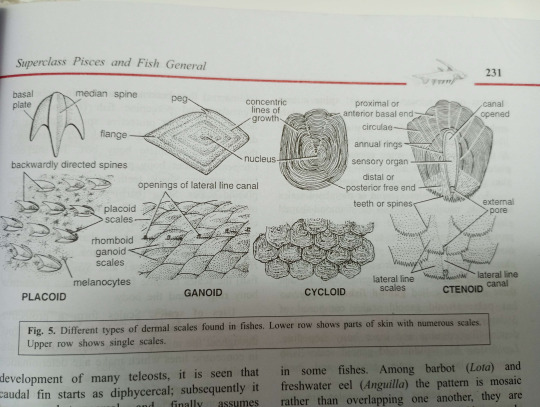
Neoteny and Paedogenesis
Neoteny refers to the retention of a larval or embryonic trait in the adult body. For example the retention of larval gills in adult salamanders.
Paedogenesis refers to the development of gonads and or production of young by an immature larval animal. Examples are scattered in several groups or animals such as gall fly, liver fluke, and salamanders.
Neoteny emphasizes the retention of larval traits in the adult body while paedogenesis stresses the development of adult like gonads in the larval body.
The best example of neoteny and paedogenesis is ambystomata. Normally they live through an aquatic larval stage and transform into an air-breathing terrestrial adult. However, under certain circumstances, the larvae does not undergo metamorphosis, retains it's gills and aquatic nature, but becomes sexually mature. This sexually mature larval stage with external gills is called an axolotl.
For a while axolotls were thought to be an entirely separate genus, Siredon.
Environmental factors affect metamorphosis in many ways. Abundance of food, cold temp., and insufficient iodine may cause failure of metamorphosis and paedogenesis. This is known because drying of swamps, lack of food, and rise in temp induce axolotls to metamorphose. When treated with thyroxine or TSH, they lose their gills and become adults.
There are 3 types of neoteny, partial, intermediate and total.
Partial neoteny is then metamorphosis is delayed due to temporary ecological or physiological changes, seen in tadpoles over winter.
Intermediate neoteny is when the organism is sexually reproductive and can undergo metamorphosis under the correct conditions, seen in axolotl.
Total neoteny is when they remain larval throughout. Even after treatment of thyroxine, they fail to metamorphose. Seen in Siren.
Parental Care in Amphibians
Parental care is the act of looking after the eggs or young until they are independent enough to defend from predators.
Amphibians exhibit various types of parental care in two broad groups: Protection by nests, nurseries, or shelters and direct caring by parents.
Protection by nests, nurseries, or shelters:
1. Selection of site: Many amphibians lay their eggs in protected moist microhabitats. Some frogs and toads lay eggs on land near water. Many tree frogs lay their eggs on leave and branched overhanding water by gluing their eggs, they fall into water free of predators when hatched. Some tree frogs deposit eggs in water that accumulates in epiphytic tropical plants, free from aquatic predators.
2. Defending eggs or territories: Male green Rana frogs maintain territories and attack small intruders to protect the eggs. Both male and female Mantophryne frogs guard the eggs. The male actually sits over and holds the gelatinous envelope containing 17 eggs.
3. Direct Development: In some frogs such as Hyla, the eggs hatch directly into little frogs, thus avoiding the chance of larval mortality. In the red backed salamander, the hatchlings are miniature adults.
4. Foam Nests: Many amphibians convert copious mucous secretion into nests for young. Japanese tree frogs dig a hole or tunnel into which eggs are left in a frothy mass to avoid desiccation. During rain, the hatching tadpoles are washed down the slopping tunnel into pond or river water for further development. Some frogs lay eggs in nests of foam floating on water. The female emits a huge amount of mucus that she can beats into foam with her hindlegs to lay eggs in. When tadpoles hatch they drop from foam into water.
5. Mud nests: Brazilian tree frog, Hyla, the male frog digs little holes in the mud of shallow water for the female frog to lay eggs in. The nest is 30cm in diameter and 5-8cm deep. Tadpoles hatch within this safe place and develop until they are large enough to defend themselves.
6. Tree nests: The South American Tree frog, Phyllomedusa, lays eggs in a folded leaf nest with margins glued together with cloacal secretions. The tadpoles when formed fall straight into water below.
7. Gelatinous bags: Salamandrella, a small aquatic salamander, deposits 50-60 small eggs in a gelatinous bag which is fastened to aquatic plants.
Direct Carrying By Parent
1. Coiling around eggs: In certain caecilians like Ichthyophis, the female lays large eggs in burrows in damp soil and carefully guards them by coiling her body around them until they hatch.
2. Transferring tadpoles to water: Some species of small frogs in tropical Africa and South America deposit their eggs on ground. Once the tadpoles hatch, they fasten themselves to the back of one of the parents with their sucker like mouth so they can be transported to water.
3. Eggs glued to body: Many amphibians carry the eggs glued to their body. In the Sri Lankan tree frog, the eggs are glued to the belly of the female. In the European midwife toad, Alytes, the mall entangles the eggs around his hindlegs so he can carry them with him until they are ready to hatch. When the time comes they release the tadpoles into the nearest water body.
4. Eggs in back pouches: In a group of tree frogs called marsupial frogs, the female carries the eggs on her back. Either in an open oval depression, a closed pouch, or individual pockets. The eggs develop into miniature frogs before leaving their mother's back.
5. Organs as brooding pouches: Males of the terrestrial South American Darwin's frog, Rhinoderma, pushes at least 2 fertilized eggs into his large vocal sacs. There they undergo complete development to emerge out as fully formed froglets.
6. Viviparity: Some anurans are ovoviviparous. They reatain eggs in the oviducts and the female gives birth to living young. For example African toads give birth to little frogs.
#zoology#vertebrates#fish#frog#neoteny#parental care#fins#scales#notes#biology#exam season#please help#amphibians#axolotl
64 notes
·
View notes
Text
I didn't respond directly but someone was irked that Wolverine's teeth were white when the rest of his skeleton is laced with adamantium. It made no scientific sense to them.
Anyway teeth are just an evolution of a placoid scale and scales grow back if you break 'em. Humans get two sets of teeth before we naturally inhibit their regrowth, but theoretically we can turn off the inhibitor and just grow a 3rd, 4th, 5th set of teeth in our lifetimes. So his teeth probably have regeneration/healing factor just like the rest of him.
If Stryker HAD laced them with adamantium, knowing the teeth aren't a permanent part of his physiology, it's likely that someone, Logan included, could have just broken them out and used them as tiny little adamantium tools of some sort.
While Logan with an adamantium grill might look cool, it's more realistic for his teeth to look... brand new. Like uncannily, eerily brand new.
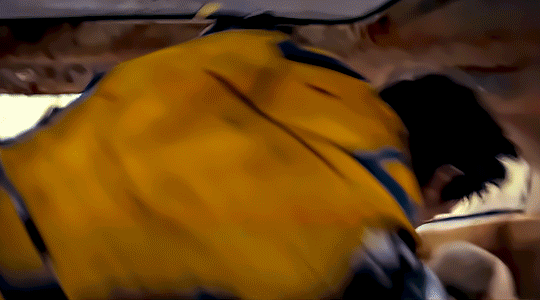

39 notes
·
View notes
Note
scalecare routine when?? 👀👀👀
depends on ur scale type!!!! and im not a pro but my tail is pretty shiny despite all the swimming i put it thru lol

here is my full mermaid tail/scalecare routine (siren friendly!)

for placoid scales, daily rinse: use a gentle sea cleanser. weekly buff: Pearl or seashell scrub for a smooth touch. monthly mask: Kelp mask for deep hydration!!!!
for cosmoid scales, daily wash: go for a pH-balanced cleanser. gentle and easy. weekly tone: seaweed toner to balance things out. keeps your scales happy and fresh! & u can also occasionally do a marine collagen mask!!
for ganoid scales, to daily clean: use a mild cleansing gel. feels as fresh as your morning ocean swim! weekly polish: sea minerals scrub to keep things smooth. monthly boost: marine protein treatment. strengthens your scales!!!!!
for both cycloid & ctenoid scales, daily wash: mild cleanser follow w/ daily hydration: light seaweed moisturizer. keeps your scales flexible and glowing. weekly exfoliate: enzymatic scrub for smoothness. Monthly Refresh: Marine botanical mask.

#mermaid#mermaid rp#mermaidcore#merfolk#aesthetic#sirencore#siren#siren aesthetic#coquette#moodboard#mermaid moodboard#mermaid aesthetic#mermaid motel#merpeople#skincare#beauty products#skincare routine#skin health#skincare tips#answered asks#merfolkkin#mermaidkin#merkin#sirenkin#underwater#otherkin
21 notes
·
View notes
Text
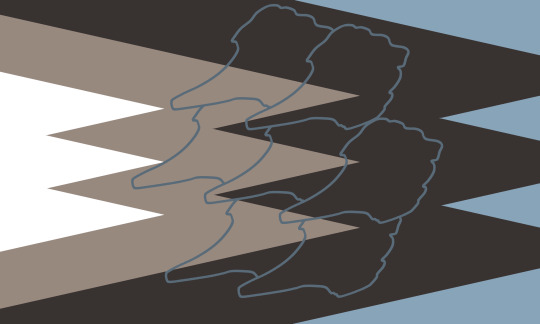
Transdermaldenticle / Transplacoidscaled

A transbody / transid in which one believes they should have Dermal Denticles / Placoid Scales
#deep sea giants ; image posts#snailfish meal ; coining post#transid#pro transid#transid coining#transid community#transid safe#pro transx#transx#transx safe#transbody#transid please interact#transx please interact#transx community#transx pride#transx coining
23 notes
·
View notes
Text
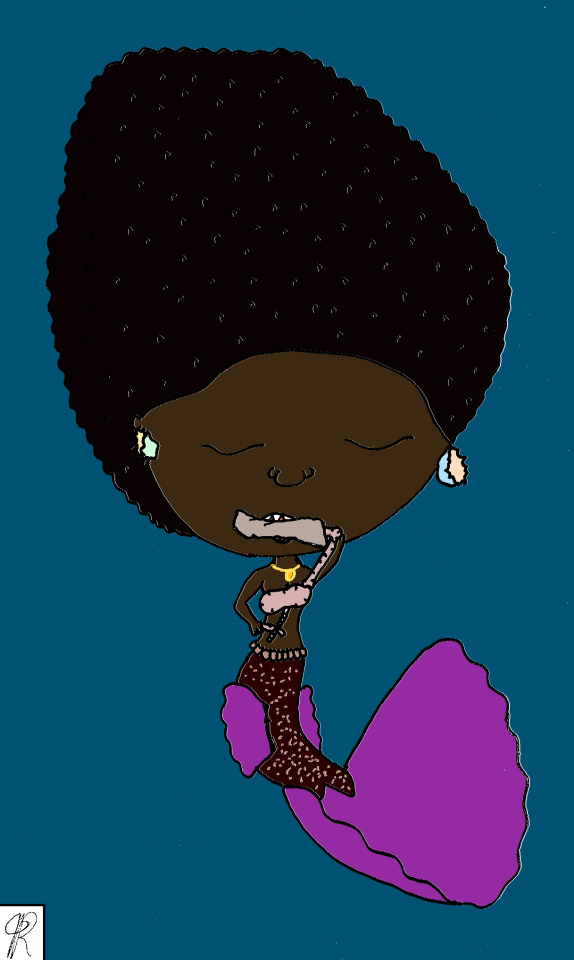
NOTES
For Draw This In Your Style from @nostalgicmermaaiid https://www.tumblr.com/nostalgicmermaaiid/776498338505834496/draw-this-in-your-style-lmao?source=share Referral https://www.tumblr.com/communities/black-artist-on-tjambler/post/779508689140875264?source=share
Coloring Page
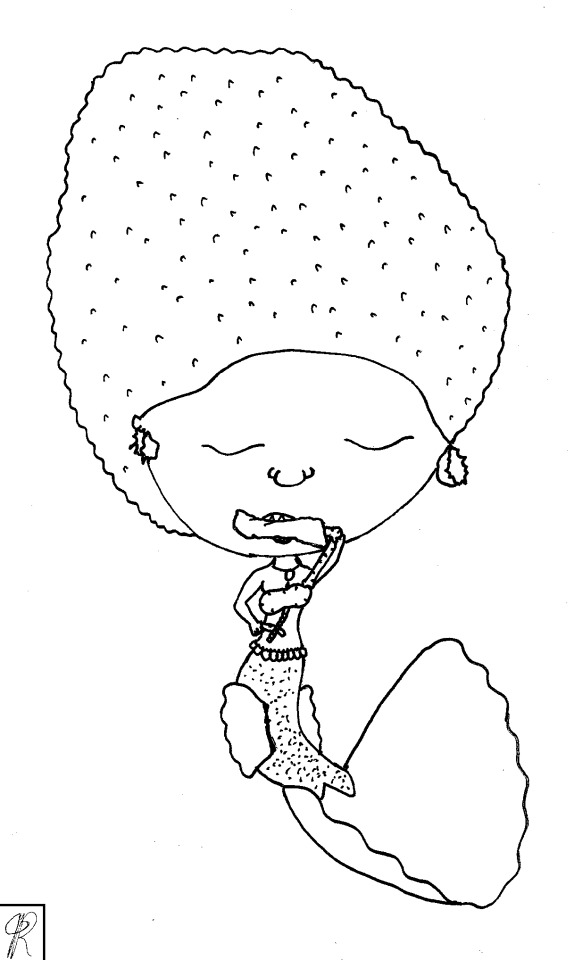
Gallery of my style and opportunity to get a character you want in my style https://www.deviantart.com/hddeviant/commission/Your-Character-In-The-Following-Style-1715303
Hair image reference https://www.flickr.com/photos/willstotler/albums/72157624690956972/ Note: I was unable to find any photo of a dark skinned Black woman with natural curly hair in the water
Her tail is based on a breed of the Betta splendens fish called Half Moon https://en.wikipedia.org/wiki/Siamese_fighting_fish video https://www.youtube.com/watch?v=6vXcid7VsNQ
youtube
ITEMS
Gold necklace Conch Shell Earrings placoid scales
4 notes
·
View notes
Text
Sharks are like so cool, did you know that sharks' skin is made up of dermal denticles, these are miniscule placoid scales that are similar to teeth, these dermal denticles are even covered in enamel, called vitro-dentine, and they also include dentine and a pulp cavity, which again makes them very comparable to teeth! Sharks are just silly little guys hehehshe!!
42 notes
·
View notes
Text
Round 1 - Phylum Chordata

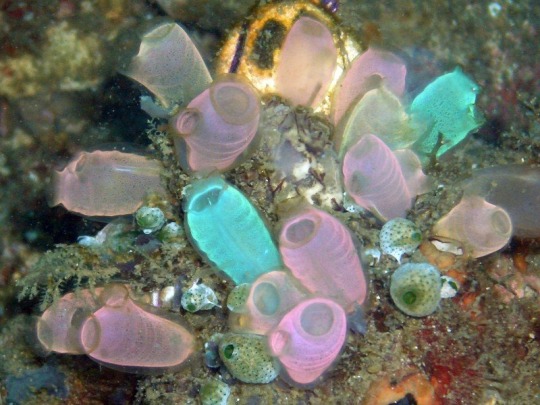


(Sources - 1, 2, 3, 4)
Chordata is a phylum consisting of bilaterial animals that have, at at least some point in their development, a notochord and a dorsal nerve chord. It consists of the Cephalochordates (lancelets), Tunicates (sea squirts, salps, and larvaceans), and Vertebrates.
Vertebrates replace their notochord with a spine in early development, while tunicates only retain their notochord and dorsal nerve chord during their larval stage. Vertebrates and tunicates are more closely related to each other than they are to lancelets (first image), which are fish-shaped filter-feeders. They typically inhabit the sea floor, burrowing the bottom halves of their bodies into soft substrate. They have gill slits, but these are used for feeding on plankton rather than respiration. They have light-sensing organs, and one frontal eye. They do not have hearts or brains. They have two sexes, though hermaphroditism has been observed, as well as at least one instance of a lab-raised female transforming into a male. They breed by releasing eggs and sperm into the water synchronously. Larvae are asymmetrical, with the mouth and anus on the left side, and the gill slits on the right side.
Most tunicates are also filter-feeders, ranging from the sessile, sponge-like sea quirts (second image) to the planktonic salps. All tunicates start life as free-swimming, tadpole-like larvae with rudimentary brains and light sensors, before they metamorphize into their adult forms. Meanwhile, the larvaceans retain tadpole-like shapes and active swimming all their lives. Salps move by contracting, similarly to jellyfish, straining phytoplankton from the water. They have a complex life cycle, in which one generation of solitary individuals reproduces asexually by producing a chain of tens to hundreds of individuals, which are released from the parent at a small size. The next generation consists of a colony of salps (called blastozooids) remaining attached together while swimming, feeding, and growing. This generation reproduces sexually, first maturing as females and later transforming into males. Older chains of male blastozooids will fertilize the eggs of younger female chains. Growing embryos are called oozooids, and eventually detach from their parent blastozoids, to feed and grow as the next solitary, asexual generation. Meanwhile, some species of sea squirt live as solitary individuals, while others replicate by budding and become colonies of zooids. They are filter feeders with two tubular openings, called siphons, through which they draw in and expel water.
The most simple vertebrates are hagfish, which have a skull but no vertebral column. They are marine predators and scavengers who can defend themselves against larger predators by releasing copious amounts of slime from mucous glands in their skin.
Lampreys have an ambiguous position in the vertebrate tree of life, bearing a complete braincase and rudimentary vertebrae. They spend the majority of their life as filter-feeders. A small handful of species are known to be carnivorous as adults, boring into other fish to consume flesh and/or blood.
Chondrichthyes (“cartilaginous fish”) have skeletons composed mainly of cartilage. They breath through gills but lack opercula (gill coverings). They have internal fertilization and some species lay eggs while others give live birth. Chondrichthyans have tooth-like scales called dermal denticles or placoid scales. These usually provide protection, and in most cases, streamlining. Today, chondrichthyans are represented by sharks, rays, skates, sawfish, and chimaeras. All species are carnivores, though at least one species is omnivorous.
The majority of chordate species are Actinopterygians (“Ray-finned Fishes”). They are so called because of their lightly built fins made of skin webbings supported by thin bony spines. They are the most abundant free-swimming aquatic animals and can be found almost anywhere there is water. They come in a vast majority of sizes, shapes, colors, and behaviors, from the 8 mm (0.3 in) long Paedocypris to the 11 m (36 ft) long Giant Oarfish (Regalecus glesne). In most actinopterygians, males and females exist and reproduce through external fertilization. However, some species utilize sequential hermaphroditism, in which they start life as females and convert to males at some point. In a few species, they start life as males and convert to females. Some species give live birth, and some species self-fertilise. Actinopterygians have feeding strategies ranging from predatory to grazing to filter-feeding.
And lastly, the Sarcopterygians (“Lobe-finned Fishes”), named for the prominent muscular limb buds (lobes) within their fins. They are represented by the coelacanths, lungfish, and tetrapods. The vast majority of the rest of chordate species are tetrapods, a terrestrial clade of sarcopterygians who evolved air-breathing using lungs. They are highly diverse, with a large variety of forms, biological strategies, and ecological roles. Along with arthropods, they are the only other group of animals to have adapted to life in dry environments, and the majority of them live on land.
Chordata is one of the largest phyla of animals when it comes to species and is also one of the oldest phyla, known from as early as the Cambrian explosion.

Propaganda under the cut:
Lancelets naturally express green fluorescent proteins. They may use this green fluorescence to attract plankton towards their mouths.
Mentioned briefly above, the Bonnethead Shark (Sphyrna tiburo), a small species of hammerhead, is the only shark known to be omnivorous. While it feeds on crustaceans, molluscs, and small fish, it also ingests large amounts of seagrass, which has been found to make up around 62% of gut content mass.
The Mangrove Rivulus (Kryptolebias marmoratus), a species of killifish, mostly breeds by self-fertilization and can survive for about two months on land. Males are rare, and can only hatch from eggs kept below 19 °C (66 °F).
The largest chordate is the Blue Whale (Balaenoptera musculus), which can reach a maximum confirmed length of 29.9 m (98 ft) and weigh up to 196 long tons; 219 short tons). While it’s not the longest, it is the largest animal known to have ever existed.
At least one of your favorite animals is probably in this phylum. Most of the animals people keep as pets are in this phylum. We are in this phylum.
I am tired, and there is no way I can write enough propaganda for this poll, so I trust you can supply your own.
#round 1#animal polls#i was lookin for a gif and I just searched Bird and Gritty was in there for some reason#and I had to be like I Mean??#I GUESS??!?!#he’s a chordate???!??#anyway WE DID IT GUYS WE MADE IT THROUGH ALL THE PHYLA#chordata
165 notes
·
View notes
Note
I love sharks. Did you know that if you pet sharks their skin feels like sandpaper or tiny-teeth thingies? Those are called placoid scales and it helps them during swimming
It’s probably weird to be proud of it because I’m old but I have multiple pairs of shark socks
-🤓
never think its weird to enjoy your interests! and thank you for sharing your shark facts!
3 notes
·
View notes
Text
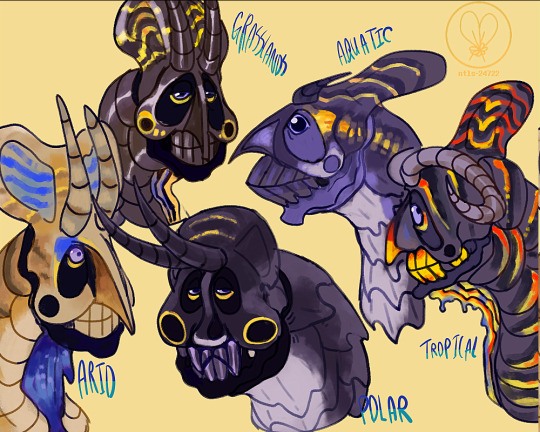
THE 5 IMMOBILE SUBSPECIES!!!!
87 million years is a long time, and while their planet is smaller after the extinction event, the low gravity leads to some CRAZY topology and land barriers and they have evolved into a bunch of seperate subspecies.
The main Sexy Accent colors are yellow-orange-red but the arid subspecies actually uses their blue blood, close to the surface of their outer sheen to create those markings, not just to be ~hot~ but also to cool themselves down. Their dewlaps have similar blue streaks when the skin is thinner for the exact same reason
The polar and aquatic immobiles have those spiky scales for their necks because they're meant to reduce drag in the water much like sharks' placoid scales. The polar ones are also semi-aquatic and are terrifying because they're evolved to eat their equivalent of whales which are fuckin water kaijus
30 notes
·
View notes
Note
Huh, didn't know sharks didn't have bones-- Did ya know sharks skin also feels similar to sandpaper? Just found that out and thought it was fun :D
:] anon
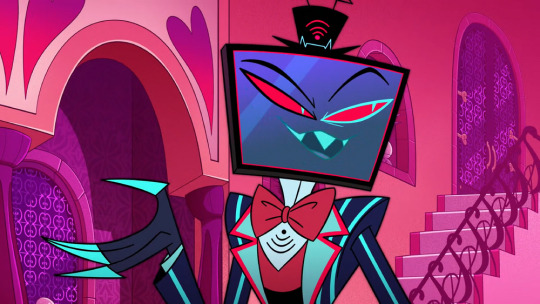
"Yep, their skeletons are purely comprised of cartilaginous tissue. And yeah, the reason for the sandpaper feel is because their skin is made up of placoid scales that help to reduce friction from the water."
#:] anon#vox#hazbin hotel vox#hazbin hotel#ask blog#hazbin hotel ask blog#rp blog#hazbin hotel rp blog#hazbin hotel roleplay#hazbin queued
8 notes
·
View notes